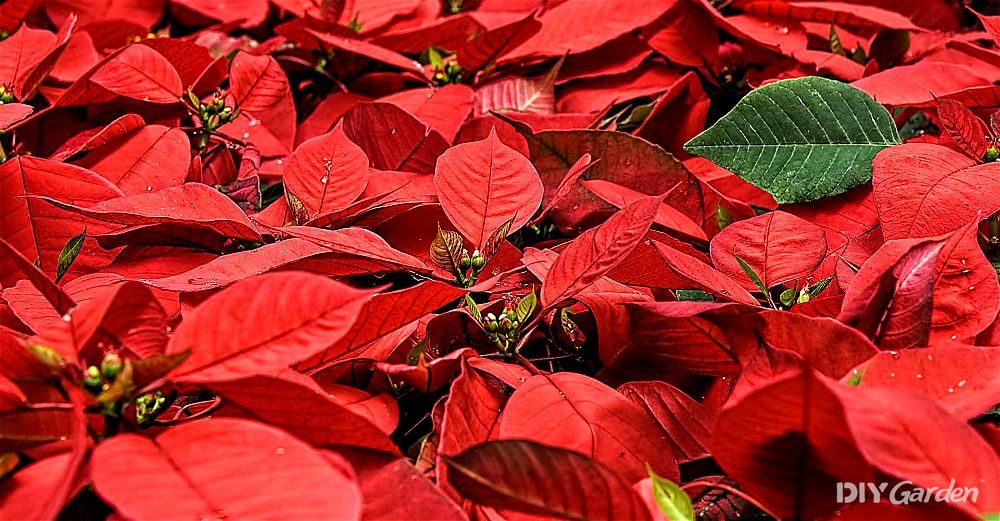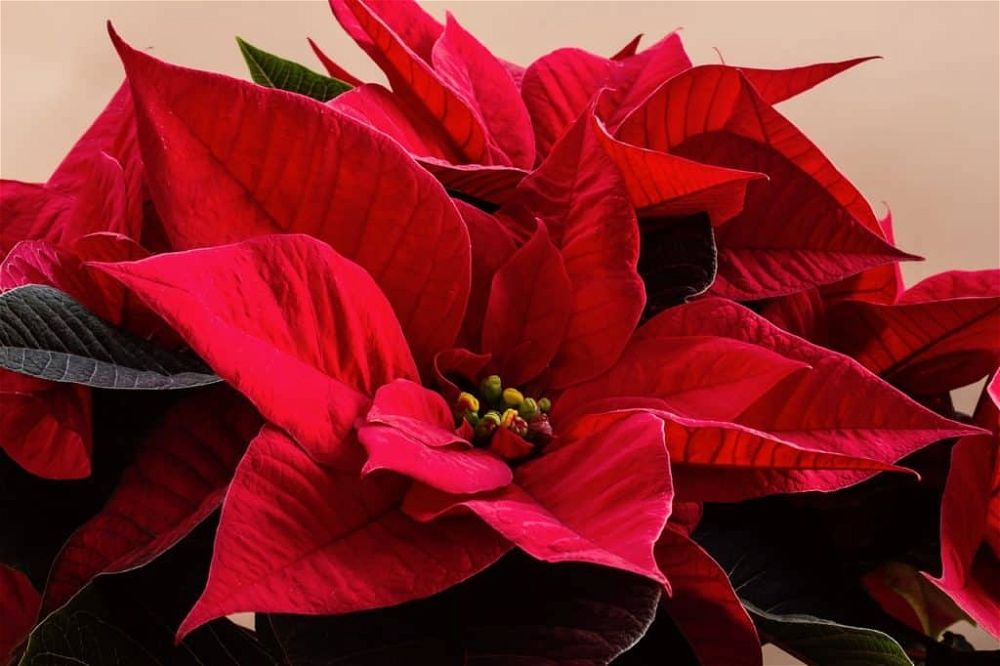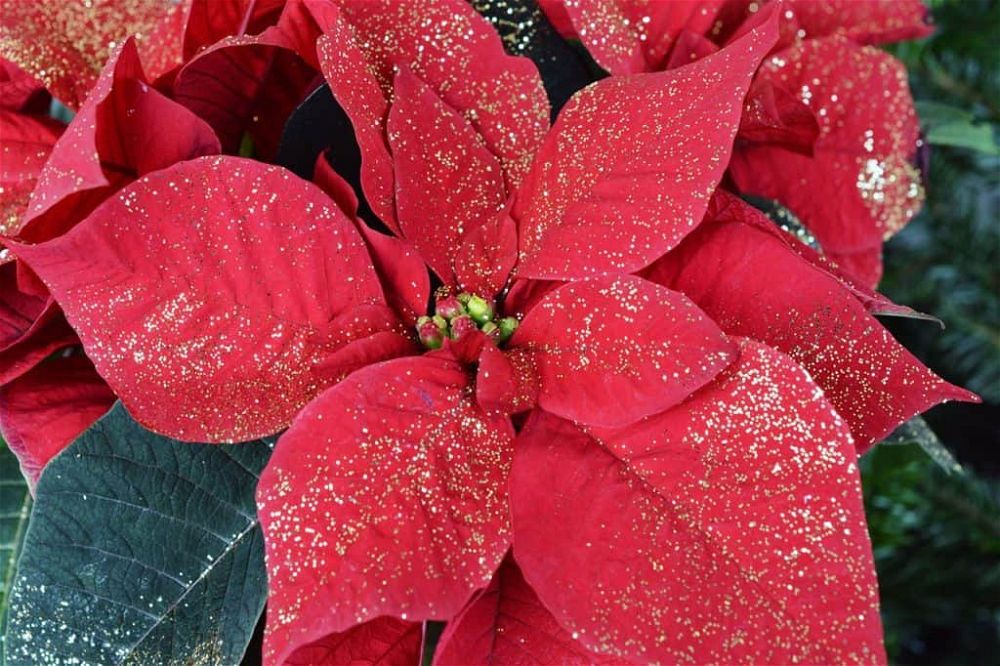
Jump to a Section
Plant Overview
| Common Name | Poinsettia, Christmas eve flower, Christmas flower, Christmas star |
|---|---|
| Scientific Name | Euphorbia pulcherrima |
| Plant Family | Euphorbiaceae |
| Origin | Mexico |
| Height | 60cm |
| Light | Bright but not direct sunlight |
| Temperature | Minimum 12°C |
| Hardiness | Tender |
| Soil | General purpose potting compost |
| Fertiliser | Monthly with houseplant feed |
| Propagation | Cutting or seed |
| Pests | Scale insect and mealybug |
| Difficulty | Easy |
Poinsettia has become the archetypal Christmas house plant. Its cheery red flowers are a common festive season sight in homes, garden centres and supermarkets across the UK. One recent estimate suggested that six million poinsettias are bought here every Christmas.
The flowers do not have petals, and the showy bright red for which the plant is famous is provided by the modified leaves (bracts) that surround the inconspicuous true flowers. These robust leafy bracts are longer lasting than typical flower petals, and they can provide a colourful display for up to three months.
Poinsettia was first taken from its native tropical deciduous forests in Mexico to the United States in 1825 by Joel Roberts Poinsett, the country’s first Minister of State to Mexico. A German immigrant to the US called Albert Ecke began selling them as potted plants from street stands in the early 1900s. When his grandson inherited the family business, he recognised poinsettia’s potential as a Christmas decoration. Through the introduction of techniques such as day-length control and the use of dwarfing compounds, the company started to produce consistent, high-quality plants on an industrial scale.
With clever marketing, including prominent roles in Hollywood movies, poinsettias soon developed a fashionable fan base. Many Christmas connections were conceived, such as the suggestion that the star-shaped pattern created by the leaves symbolised the star of Bethlehem. Thanks initially to these US exports, poinsettias have been used as Christmas ornaments in the UK and elsewhere in Europe for nearly a hundred years. While the secrets of the poinsettia trade were replicated in many countries around the world in later decades, the Ecke business is said to still supply nearly half of all of the poinsettia plants sold around the world.
In fact, the poinsettia’s connection with Christmas had started many years earlier in its native Mexico, where a legend relates that a poor Mexican boy, unable to afford a gift to take to church, collected the colourful red weeds as his Christmas offering.
Poinsettia is a member of the 7500-strong Euphorbia family, and its Latin name ‘pulcherrima’ translates roughly as the most beautiful of all. In common with most spurges, poinsettia sap and latex is toxic and can cause a mild allergic reaction in sensitive people. If ingested in quantity, it can cause diarrhoea or vomiting, and it can lead to temporary sight problems if it splashes into the eye.
This article gives advice on getting the most out of a Christmas poinsettia.
Poinsettia Care
As they are generally bought in the winter, the proper care of a poinsettia needs to begin with its purchase and journey home. Many supermarkets display poinsettias with the cut flowers in the lead-up to Christmas, often just inside the store’s front door to tempt customers with an impulse buy on the way in or out. Some even display them in porches or outside the building. That impulse should be resisted, as the cold and draughts are likely to have damaged the plant, and it should come as no surprise if it first drops its leaves on reaching home, followed shortly afterwards by the flowers.
Properly cared-for supermarket specimens may survive, but plants from heated greenhouses at reputable garden centres or professional nurseries are more likely to be successful. Even so, temperatures on the journey home are likely to be lower than the plant appreciates, and care is needed, as such conditions can damage the foliage. Have the whole plant wrapped or placed in a plastic bag so that it is completely protected, and minimise exposure to the cold and wind.
Poinsettia benefit from proper attention to water, light and temperature conditions. Once home, water poinsettias sparingly, and only water when the surface of the compost has begun to dry out. Regular misting can extend the longevity of the flower.
The plants need warmth and light to perform at their best. A bright spot in a centrally heated room between 18°C and 21°C is ideal, but not too close to radiators or other heat sources. Avoid south-facing windowsills in direct sunlight. Poinsettia is easily damaged by draughts, so they should be kept away from open fireplaces, open windows or draughty hallways.
Light requirements
Poinsettias need bright, but filtered light, away from strong sun.
The bract colours are influenced by photo-periodism, and to develop full colouration they require 14 hours of complete darkness at a time for several weeks in a row in early winter. Any incidental light can inhibit colour production. Over the same period, the plants require abundant light during the day if they are to develop the brightest pigmentation.
Watering
The plant’s roots should not be allowed to dry out, but they must also never be waterlogged, nor allowed to stand in a dish of surplus water, which can lead to root rot and the death of the plant. They are more likely to be damaged by overwatering than under-watering.
Soil conditions
Any good quality house plant potting compost is suitable.
Fertilisers
Feed monthly with a low nitrogen, high potassium liquid house plant fertiliser.
Re-potting
If poinsettias need to be potted on, use a mixture of three parts of John Innes No 3 to one part of horticultural grit or vermiculite.
Looks good with
Poinsettia is something of a marmite plant. People tend to either love it for what it is – and particularly for its cheerful Christmas connotations, or they hate it for the same reasons! It has become very commercial, and fans can buy a wide range of Christmas themed arrangements, from wicker baskets with variegated ivy and plastic holly through to miniature plants in tiny glass containers that double up as name markers for the Christmas table.
Pruning
Pot plants bought for the festive season will not need pruning. If plants are kept for subsequent winter displays, they will need to be hard-pruned in April. Even so, they will tend to become leggy and woody, and specialised care and management is needed to successfully produce an attractive plant for a second Christmas.
Poinsettia Propagation
There are two approaches to home poinsettia plant propagation, sowing seeds or taking cuttings.
Seeds can be bought or collected from plants raised in a greenhouse, but there will be some uncertainty as to the nature of the plants that will produced. The seed pods should be removed from the plant when they start to turn brown. Store the pods in a paper bag in a cool, dry place until they are fully dry. At this stage, the pods should burst to reveal the seeds, which should be sown into trays of seed compost straight away. Cover the seeds with a very thin layer of compost or vermiculite.
Keep the trays in a warm place, but not in direct sunlight. Water the compost frequently but sparingly to ensure that it is constantly moist, and seedlings should germinate within two to three weeks. The seedlings can be pricked out into individual pots for growing on.
Poinsettias can also be propagated by softwood cuttings in May, and this ensures that the offspring are identical to the parent plant. When taking and handling cuttings, plastic gloves should be worn, as the milky sap is a skin irritant that can provoke allergic reactions.
For the best results, take 75cm to 150cm cuttings from a healthy plant when it is still growing vigorously in early summer. Dip the freshly cut end of the cuttings into a proprietary hormone rooting powder and insert them into moistened potting compost in individual pots. Place the pots in a bright position in an unheated greenhouse, cold frame or on a windowsill, but not in direct sunlight. Put supported plastic bags over the pots to maintain a high humidity around the cutting, but do not let the bag touch the plant. The cuttings should show signs of rooting and fresh growth after about a month.
Common Poinsettia Problems
Pests
Poinsettias are rarely seriously affected by pests, though they can be attacked by common indoor plant insects such as scale insect and mealybug.
Diseases
Poinsettias can suffer from grey mould when overwatered, and old or inferior plants occasionally suffer problems with other fungal or bacterial diseases. Affected plants should be disposed of and replaced.
Poinsettia Varieties
There are over a hundred registered poinsettia cultivars and breeders are developing new varieties. In addition to the original fiery red, new scarlets, burgundies, oranges, and pastel shades of yellow, pink and cream are now available, along with bi-colours and some that have marbling or speckles of white on the red bracts.
Euphorbia pulcherrima ‘Mars Improved’
This is one of the latest varieties in the Mars series and a good example of the typical Christmas red poinsettia.
Euphorbia pulcherrima ‘Silver Star’
‘Silver star’ is one of the more popular pink-flowered varieties. It has the additional interest of variegated leaves.
Euphorbia pulcherrima ‘Lemon Snow’
This is the one of the best choices for a yellow variety, with long-lasting, pale lemony-coloured bracts.
Euphorbia pulcherrima ‘Arctic White’
This creamy white variety looks good alongside the red varieties, or alone it provides a more unusual, subtle and less garish decoration for the Christmas table.
Euphorbia pulcherrima ‘Burgundy’
This darker-red, almost plum-coloured variety became fashionable a few years ago but it has fallen from popularity more recently.
Euphorbia pulcherrima ‘Sonora White Glitter’
‘Sonora White Glitter’ has been named to play on the Christmas theme, and is marketed as having Christmas red bracts with a glittery appearance, almost as though they have been spray-painted. The leaves are quite holly-like, adding to the Christmassy theme.
Euphorbia pulcherrima ‘J’adore’
Poinsettias have always been associated with fashion and marketing-driven demand, and as the proportion of red-flowered plants declines in favour of more sought-after pinks, cultivars such as ‘J’adore’ have been bred to create further demand, It has a vivid pink colour and an extra swirl of bracts.
FAQs
Despite best efforts, poinsettias in the home are generally disappointing in their second year. They are not naturally long-lived plants, but despite the fact that they are cheap to buy and the onerous rules that need to be followed through the intervening months, many people consider it a badge of honour to successfully keep their poinsettia until the next Christmas!
For the best chances of success, prune the plant back by half or to about 10cm in April and keep it somewhere out of bright light for a couple of weeks at a temperature of 13°C. Re-pot the plant into a larger container in early May, and transfer it to a bright place out of direct sunlight at a temperature of around 15°C to 18°C for the rest of the summer to put on some new growth. This can be a cold frame or sheltered position outside, though it must be brought back inside when night temperatures are projected to fall below 12°C. It should be fed fortnightly with a high potash fertiliser and kept adequately watered so that the lower part of the compost round the roots is always moist.
Achieving flowering and full bract colouring is the difficult part in a temperate northern hemisphere context. The process is initiated by a carefully controlled schedule of day and night length. From late October onwards, plants should be subjected to a daily routine of fourteen continuous hours in a totally dark environment and ten hours of bright daylight. Any chink of light or artificial light sources such as televisions will interfere with the need for total darkness and undermine the effort. Placing a thick cardboard box over the plant or putting it into a completely lightproof cupboard for the night are good strategies.
Throughout this process, the plants require a more or less constant day-round temperature of 15°C to 18°C to colour up well. If successful, buds will form and the bracts will colour up by the end of November and the pot can be brought out into the home as the new festive season approaches.
However, it is very unlikely that a home managed plant will ever achieve the form that it had when it was originally purchased, as commercially grown poinsettias are treated with growth depressant and dwarfing chemicals to achieve the desired stature, and plants grown on for a second year generally revert to a leggier and woody type.
For this reason, poinsettia sceptics suggest an alternative approach to post-Christmas management of the plants:
- When the plant starts to look tired in late winter, use secateurs to cut off all of the stems.
- Place all of the cut material onto the compost heap.
- Leave the pot un-watered in a forgotten corner outside for the roots to rot and then add the old compost to improve the soil when digging over the vegetable patch in the autumn.
- In December, buy a new poinsettia!
A container grown poinsettia from a garden centre is relatively easy to sustain over a few months in the winter, after which it can be thrown away. However, it is a living thing, so it does need some care and attention during that time, including watering and a little tender loving care.
If you really cannot keep plants alive, why not buy some poinsettias from the supermarket, cut off the flowerings stems and use them to make a preserved floral arrangement. For a long-lasting display, cut the flowering stems off the plants, dip the cut ends into a pan of boiling water for 30 seconds and then immediately transfer them into cold water for a further 30 seconds. This should keep the bracts and leaves vibrant and red for up to a week. Arrange the treated stems in a vase with other Christmas favourites such a holly and stems of variegated ivy.
Unhealthy poinsettias have a habit of quite quickly turning yellow and looking decidedly un-festive. There are a number of possible causes, but watering is likely to be at the root of the problem. Poinsettias that are water-stressed or waterlogged tend to respond by yellowing, then dropping leaves. The compost should be kept moist by watering frequently but sparingly, and any excess must be allowed to drain away completely. Do not stand the pots in saucers of water.
If the plant has been watered appropriately, the yellowing could have been caused by a mineral deficiency, though over-feeding can also can burn the leaves and turn them a yellow-brown. Root rot could also be the cause, though this will almost inevitably be associated with over-watering. Whatever the cause, give the plant one last chance by re-potting it into fresh compost, make sure the position is suitable, and review the watering and feeding regime.



Share